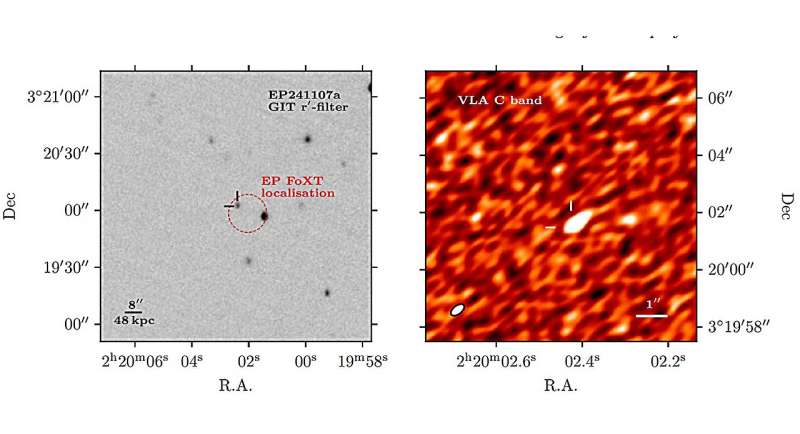
The location of the counterparts to EP241107a in optical and radio bands is shown. Credit: arXiv (2025). DOI: 10.48550/arxiv.2511.02562
Astronomers have conducted multiwavelength observations of a recently detected fast X-ray transient designated EP241107a. Results of the observational campaign, published November 4 on the arXiv preprint server, shed more light on the nature of this transient, suggesting a gamma-ray burst origin.
In general, fast X-ray transients (FXTs) are bursts in soft X-rays lasting from a few hundred seconds to several hours. They are very difficult to detect because they occur at unpredictable locations and times and their activity is very brief. Moreover, their nature is still puzzling. However, astronomers trying to explain their origin take into account several scenarios; for instance, stellar flares, supernova shock breakouts, and long gamma-ray bursts (GRBs).
A mysterious transient
EP241107a is an FXT detected on November 7, 2024 with the Wide-field X-ray Telescope (WXT) onboard the Einstein Probe (EP)—a Chinese space telescope launched into space in January 2024. The transient has an optical counterpart, which was identified in the Ic-band at a magnitude of 17.85.
Given that the nature and properties of EP241107a remain uncertain, a team of astronomers led by Deepak Eappachen of the Indian Institute of Astrophysics in Bengaluru, India, decided to inspect this transient with the use of ground-based telescopes, including the GROWTH-India Telescope (GIT) and Himalayan Chandra Telescope (HCT).
“We use our multiwavelength observations of the transient counterpart, along with publicly available data, combined with our afterglow and host modeling, to derive constraints on the nature of EP241107a,” the researchers wrote.
Constraining FXT properties
First of all, the observations detected a radio counterpart of EP241107a at 10 GHz and 6 GHz, with flux densities of about 232 and 207 𝜇Jy, respectively. The spectroscopic redshift of the transient was determined to be 0.457.
EP241107a had an X-ray luminosity of about 3.4 quindecillion erg/s (in the 0.5-4 keV band) when detected with EP. Therefore, its X-ray luminosity was higher when compared to the predicted X-ray luminosities of typical supernova shock breakout (SN SBO).
The study found that approximately 60 minutes post-detection, an X-ray afterglow with a luminosity of 0.012 quindecillion erg/s was detected in the 0.5–10 keV band. This X-ray counterpart declined rapidly.
When it came to the host galaxy of EP241107a, the observations found that it has a stellar mass of about two billion solar masses and its star formation rate was estimated to be at a level of 0.6 solar masses per year.
Gamma-ray burst origin
Summing up the results, the astronomers compared the optical and radio observations of EP241107a and its host galaxy properties with other extragalactic transients. The comparison points to a gamma-ray burst (GRB) origin of this transient.
“We compared the radio and optical light curves of EP241107a with those of other transients and found that EP241107a is consistent with the parameter space occupied by GRB afterglows,” the astronomers concluded.
However, the authors of the paper noted that the absence of gamma-ray emission, the inferred on-axis viewing geometry and the energetics derived from afterglow modeling all together suggest that EP241107a is an intrinsically faint GRB.
Written for you by our author Tomasz Nowakowski, edited by Stephanie Baum, and fact-checked and reviewed by Robert Egan—this article is the result of careful human work. We rely on readers like you to keep independent science journalism alive.
If this reporting matters to you,
please consider a donation (especially monthly).
You’ll get an ad-free account as a thank-you.
More information:
D. Eappachen et al, Characterising EP241107a: Multiwavelength Observations of an Einstein Probe-detected Fast X-ray Transient, arXiv (2025). DOI: 10.48550/arxiv.2511.02562
Journal information:
arXiv
© 2025 Science X Network
Citation:
Observations suggest GRB origin for fast X-ray transient detected by Einstein Probe (2025, November 11)
retrieved 11 November 2025
from https://phys.org/news/2025-11-grb-fast-ray-transient-einstein.html
This document is subject to copyright. Apart from any fair dealing for the purpose of private study or research, no
part may be reproduced without the written permission. The content is provided for information purposes only.
